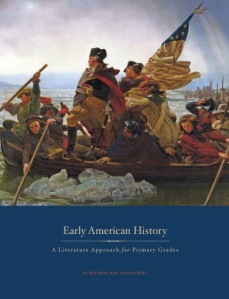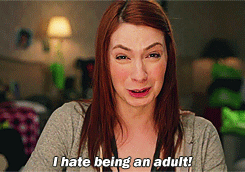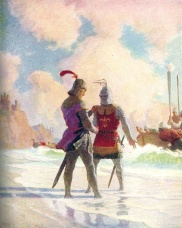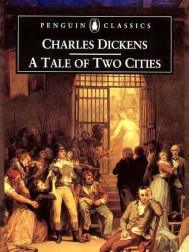I've written about curiosity before on this blog (click
here and
here to read previous entries) and I'm more and more convinced that it is innate to human beings and an absolutely essential element in fostering a love of learning.
Baby's curiosity
My nearly five month old son has displayed his curious nature from the first week of his life. As I type this now he's sitting on my lap, watching my fingers on the key board then bobbing his head up to look at the books on the bookshelves. My hands are dribbled with drool as he's been teething but he's much happier to be with me, looking around, than sitting in a bouncy seat or lying on his back. He wants to be upright and checking things out. He wants to grab at my fingers and listen to the clicking of the key board, he wants to coo and make new sounds with his newly discovered lower lip. It is not that easy to type with an infant in your lap as I'm sure many of you can attest to, but seeing his growing awareness of the world around him is so rewarding...as well as a little scary. I want to insure that he's being adequately stimulated but given the room to develop an ability to entertain himself and use his imagination.
The desire to explore
To that end I purchased a book recommended by my sister called
Brain Rules for Baby by John Medina. It's been a fascinating read and I've enjoyed it. And the book reinforced my conviction of the importance of nurturing your child's curiosity. Medina promises to give parents the keys to raising a "smart and happy child." To do that he looks at today's leaders, innovators, and thinkers, analyzed research on brain development and came up with what he calls "5 essential ingredients" that make up human intelligence. The very first element is a "desire to explore". He quotes Hal Gregerson, lead author of a study published in
Harvard Business Review as stating the following:
"You can summarize all the skills we've noted in one word: 'inquisitiveness.' I spent 20 years studying great global leaders, and that was the one big denominator...If you look at 4-year-olds, they are constantly asking questions. But by the time they are 6 1/2 years old, they stop asking questions because they quickly learn that teachers value the right answers more than provocative questions. High-school students rarely show inquisitiveness. And by the time they're grown up and are in corporate settings, they have already had the curiosity drummed out of them."
What a sad but completely understandable outcome of traditional education. And overwhelmed teacher of 30 active little people does not have the resources to nurture the individual natures of all those students. I'm sure that this curbing of enthusiasm and curiosity is one of the reasons many of you chose to homeschool. As parents who have chosen a different educational path, we have a huge responsibility and privilege. So how do we accomplish the task of encouraging our little one's curiosity?
The myth of one "right" answer
As Gregerson observed in his research, students are quickly taught that having one "right" answer is key to success in a classroom. While that is certainly efficient and makes educating a bit easier and straightforward, I believe that this model is the one responsible for squelching creativity and imagination. When I write study guides for BFB I think a lot about curiosity and how I can help our customers support their children's innate ability to question and think outside the box. To that end, you will find very few questions with simple "right or wrong" answers in my study guides. I try to incorporation questions that make the student think a bit deeper, to see the material in a different light or from a perspective outside of their own experience.
The sandbox approach

I often utilize what I like to call a "sandbox approach" to comprehension questions. When you look at a sandbox, there are specific boundaries that mark the area in which a child can safely play. These boundaries provide structure and security. Within the sandbox there is plenty of room for a child to explore and play. She can create new things, tear down castles left behind by others, shift sand and toys from one area to another. In other words, within the bounds of the sandbox, the child has a lot of freedom. I think of curriculum and study guides as the boundaries of a sandbox. They are there to provide structure and within that structure there ought to be a lot of room for individual students to develop their own style of learning, to be able to ask provocative questions, to try on different perspectives. At BFB we put a lot of effort into thinking about how to empower parents to teach their children in a way that is enjoyable and encourages the development of curiosity. Our study guides are not designed to be rigid but to help you to tackle the idea of trading in your history textbook for a pile of literature. That can be a scary endeavor and we are here to help you unlock the richness of a literature based education. And we want to encourage your student to bring his or her unique observations and perspectives to that literature and that is why we rely more on discussion questions than we do comprehension questions. This approach is not for everyone, but for those of you who want to take the road less traveled, we're happy to take this journey with you.
We would love to hear what you think! Chime in below in the comments section and share your thoughts. Don't forget to check out our Facebook and Pinterest pages. To learn more about Beautiful Feet Books, click here. And if you've enjoyed this, please feel free to share using the buttons below!






 of the evil effects of slavery on an entire society, slave and master alike, turned the conscience of a nation and became a powerful catalyst for change.
of the evil effects of slavery on an entire society, slave and master alike, turned the conscience of a nation and became a powerful catalyst for change.
.jpg)




 One of the topics I will be speaking on is: Classic Literature for Character Building (or Character Through Literature), so I wanted to take a moment to give a brief overview of what my session will cover as you make plans for your GHC weekend!
One of the topics I will be speaking on is: Classic Literature for Character Building (or Character Through Literature), so I wanted to take a moment to give a brief overview of what my session will cover as you make plans for your GHC weekend!



